
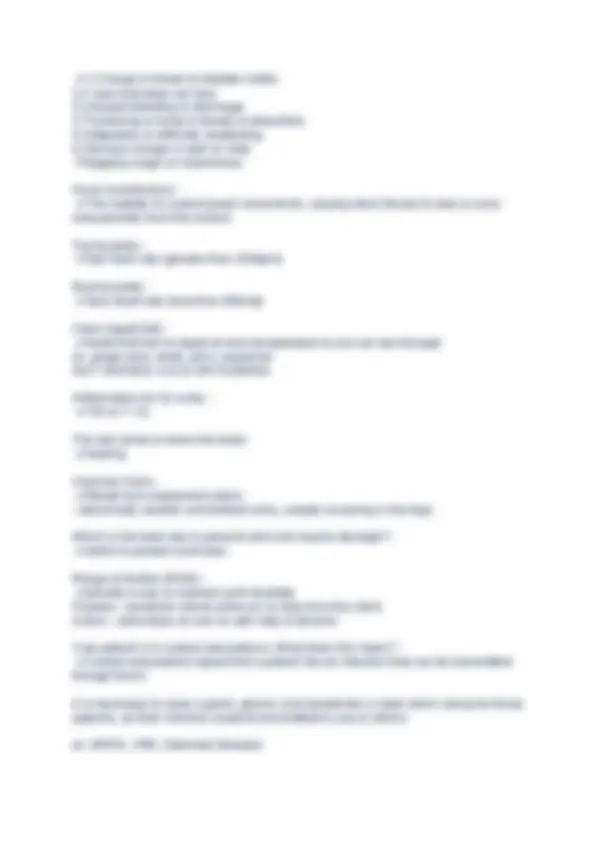
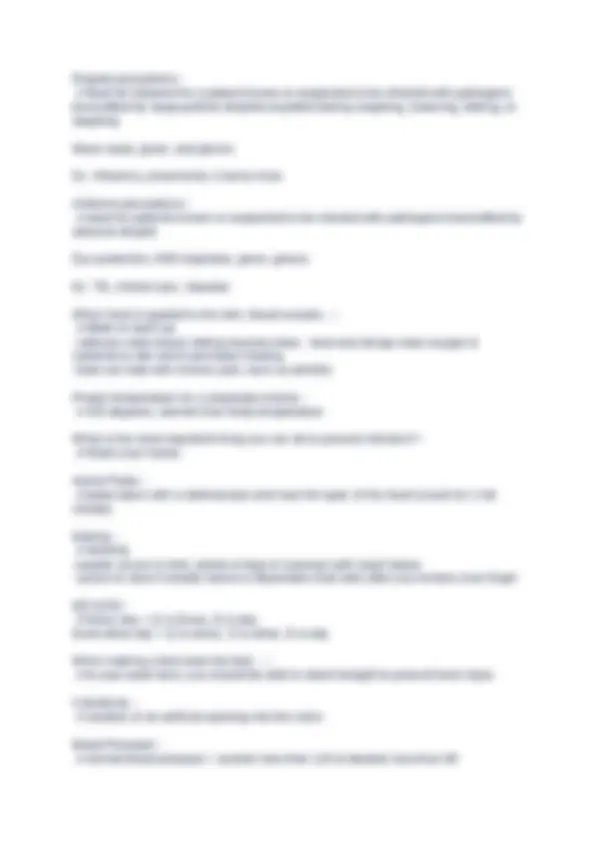
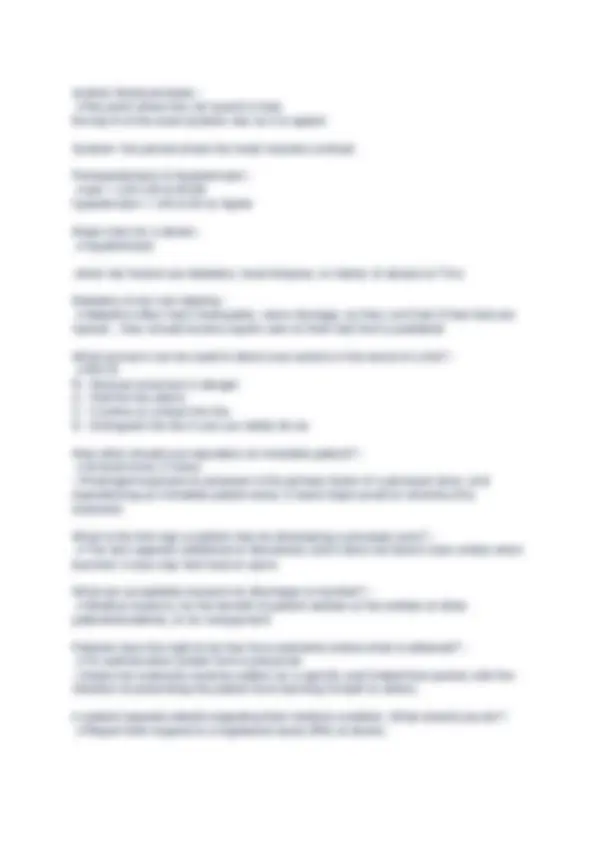
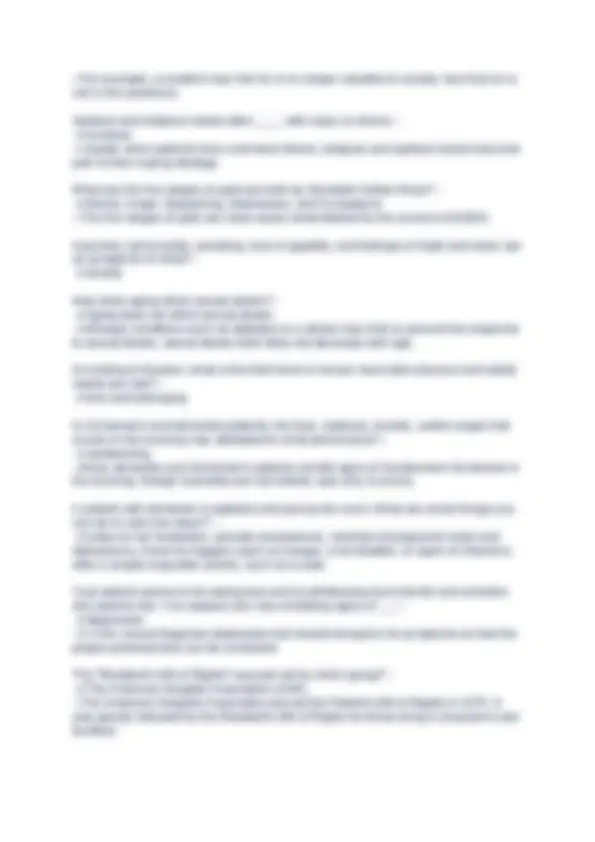
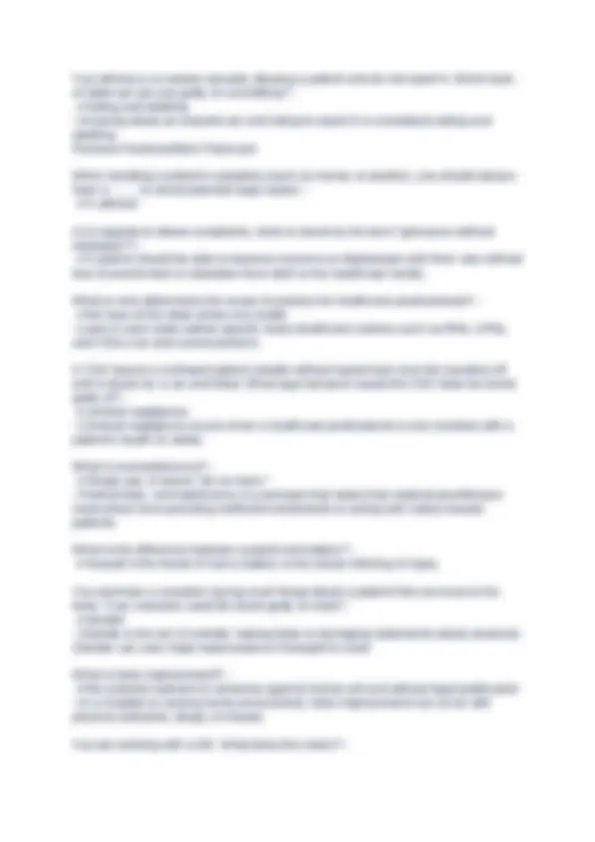
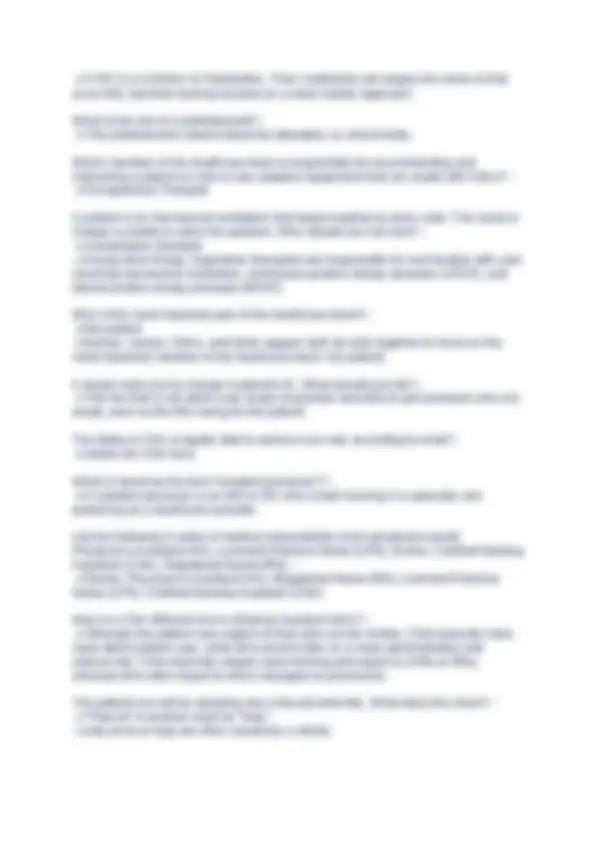
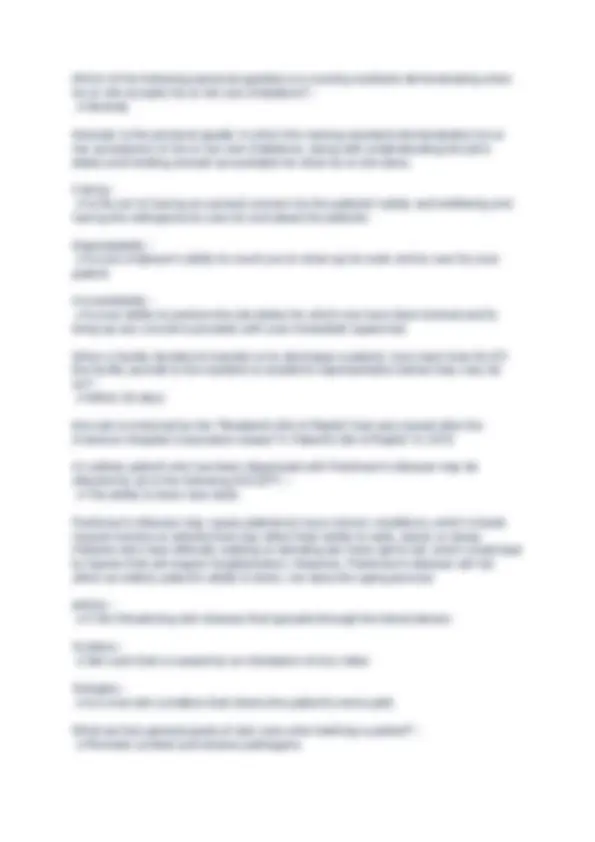
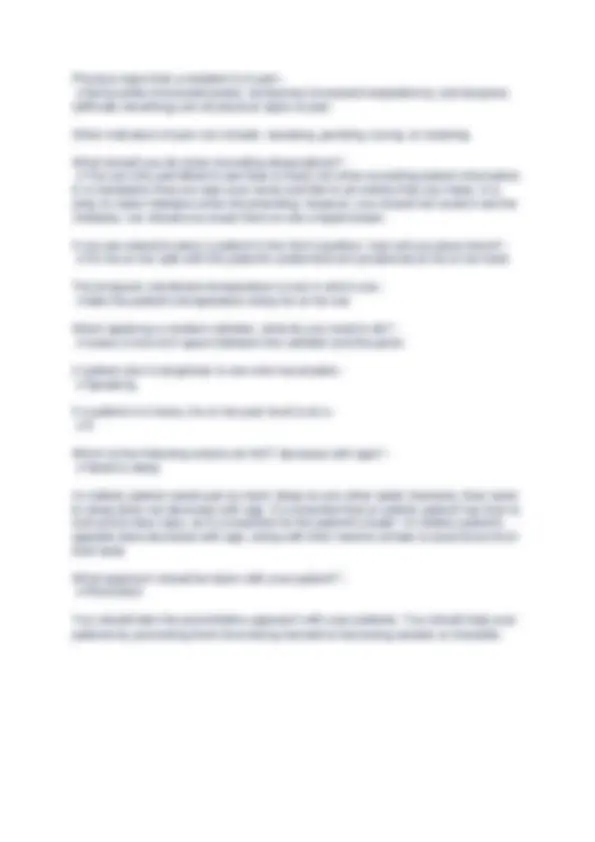


Study with the several resources on Docsity

Earn points by helping other students or get them with a premium plan


Prepare for your exams
Study with the several resources on Docsity

Earn points to download
Earn points by helping other students or get them with a premium plan
Community
Ask the community for help and clear up your study doubts
Discover the best universities in your country according to Docsity users
Free resources
Download our free guides on studying techniques, anxiety management strategies, and thesis advice from Docsity tutors
NA Competency Exam 143 Questions and correct Answers 2023.docx
Typology: Exams
1 / 14

This page cannot be seen from the preview
Don't miss anything!









How long should you soak a patient's fingernails before performing nail care? - ✔️10-20 minutes (in warm water) Some patients may have special nail care instructions due to circulatory issues in the hands or feet. Name two diseases that are likely causes of these circulatory issues. - ✔️Raynaud's disease and diabetes Signs and symptoms of shock may include - ✔️low blood pressure, tachycardia (rapid hears rate), clammy & pale skin What are the two parts of the nervous system? - ✔️CNA-central nervous system (the brain & the spinal cord) and PNS- peripheral nervous system (the body's nerves) When not in use, where should dentures be stored? - ✔️In a denture cup filled with clean water --Storing your dentures in a cup filled with clean water helps prevent damage to the dentures. When helping a patient who is recovering from a stroke to walk, the nurse aide should assist where? - ✔️on the patient's weak side When providing mouth care to a patient, which position should they be in? - ✔️Fowler's -Fowler's is an upright position that helps minimize aspiration. When feeding a patient, how often should you offer fluids? - ✔️At minimum, every 3 to 4 bites of food When shaving a patient, you should always shave in the direction of what? - ✔️hair growth --When shaving a patient's face, you should shave downward; when shaving the neck, you should shave upward. What is a partial bath? - ✔️A partial bath occurs in bed. It differs from a complete bed bath in that the patient is able to perform some of the bath himself, and the healthcare worker is only there for assistance. When is the best time to bathe a patient? - ✔️When they choose. --Although this may be inconvenient to the busy schedule of the nursing assistant, patients have the right to choose when and how often they bathe.
What are some ways you can ensure a safe showering experience for your independent patient? - ✔️Check the water temperature before the patient gets in the shower, make sure the floor is uncluttered and free of slippery substances, ensure the patency of safety rails and chairs, and have all supplies in easy reaching distance of the patient. What type of tooth brush bristle is considered the universal best choice? - ✔️soft --Medium or hard bristle toothbrushes may be considered too irritating for some patients. What is the normal pulse rate in the average adult? - ✔️60-100 beats per minute --The average adult should have a pulse rate of 60 beats to 100 beats per minute. Where would you take a radial pulse? - ✔️On the radial (thumb) side of the patient's wrist --The radial pulse should be taken using the index and middle fingers. How far should an enema be inserted into the anus? - ✔️2-4 inches --If you feel resistance or if the patient complains of pain, stop inserting the enema and report the incident to the nurse. What is the standard unit of measurement to record fluid intake and output? - ✔️Cubic centimeters (cc) or milliliters (ml) --Although cc and ml are equal units of measurement, always use the value that is preferred by your facility. A bedridden patient has a urinary catheter. Where should the drainage bag be stored? - ✔️The urinary drainage bag should be secured to the bed frame --Never place the urinary drainage bag on a movable part of the bed (such as a side rail) because that may dislodge the catheter. Your patient has been placed on I&O this means you should... - ✔️Record all the fluid intake and output Muscle astrophy - ✔️muscles decrease, typically due to lack of movement and exercise Before meals & After meals - ✔️before= AC After= PC Muskuloskeletal System - ✔️gives the body framework, protects organs, allows movement, and maintains structure 7 Signs of Cancer -
Droplet precautions - ✔️Must be followed for a patient known or suspected to be infected with pathogens transmitted by large-particle droplets expelled during coughing, sneezing, talking, or laughing. Wear mask, gown, and gloves Ex. influenza, pneumonia, Corona virus Airborne precautions - ✔️used for patients known or suspected to be infected with pathogens transmitted by airborne droplet Eye protection, N95 respirator, gown, gloves Ex. TB, chicken pox, measles When heat is applied to the skin, blood vessels... - ✔️dilate or open up --delivers more blood, letting muscles relax.. heat also brings more oxygen & nutrients to site which promotes healing -heat can help with chronic pain, such as arthritis Proper temperature for a soapsuds enema - ✔️105 degrees, warmer than body temperature What is the most important thing you can do to prevent infection? - ✔️Wash your hands. Apical Pulse - ✔️pulse taken with a stethoscope and near the apex of the heart (count for 1 full minute) Edema - ✔️swelling -usually occurs in feet, ankles & legs of a person with heart failure
systolic blood pressure - ✔️the point where the 1st sound is hear the top # of the read (systolic=sky so it is upper) Systole= the period where the heart muscles contract Prehypertension & Hypertension - ✔️pre = 120-139 & 80- hypertension = 140 & 90 or higher Major risks for a stroke - ✔️hypertension -other risk factors are diabetes, heart disease, or history of strokes & TIAs Diabetics & toe nail clipping - ✔️diabetics often have neuropathy, nerve damage, so they can't feel if their feet are injured... they should receive expert care on their feet from a podiatrist What acronym can be used to direct your actions in the event of a fire? - ✔️RACE R - Rescue everyone in danger. A - Pull the fire alarm. C - Confine or contain the fire. E - Extinguish the fire if you can safely do so. How often should you reposition an immobile patient? - ✔️at least every 2 hours --Prolonged exposure to pressure is the primary factor of a pressure ulcer, and repositioning an immobile patient every 2 hours helps avoid or minimize this exposure. What is the first sign a patient may be developing a pressure sore? - ✔️The skin appears reddened or discolored, and it does not blanch (turn white) when touched. It also may feel hard or warm. What are acceptable reasons for discharge or transfer? - ✔️Medical reasons, for the benefit of patient welfare or the welfare of other patients/residents, or for nonpayment Patients have the right to be free from restraints unless what is obtained? - ✔️An authorization (order) from a physician --Orders for restraints must be written for a specific and limited time period, with the intention of preventing the patient from harming himself or others. A patient requests details regarding their medical condition. What should you do? - ✔️Report their request to a registered nurse (RN) or doctor.
--Any type of information obtained directly from the patient and not an outside source is considered primary data. Your patient says he feels feverish and you noticed he is flushed and shaking. In this scenario, which information is subjective and which is objective? - ✔️The patient stating he feels feverish is subjective; the fact that he is flushed and shaking is objective. --Subjective data cannot be measured or observed, whereas objective data can be. The patient's blood pressure is 145/79. Would this data be considered qualitative or quantitative? - ✔️Quantitative --Quantitative data deal with numbers and things that can be measured, whereas qualitative data deal with words. How might a diagnosis of Parkinson's affect a patient's ability to communicate? - ✔️Those with Parkinson's may have trouble speaking or develop a "masklike" expression that makes it difficult for them to convey how they are feeling through facial expressions. You are meeting new patients for the first time. How should you address them? - ✔️Mr., Mrs., Ms, or Dr. (depending on their title), followed by their last name --Unless the patient asks you to call them otherwise, it is best to address them by their title and last name. This is both professional and respectful. You are caring for a patient who is hearing impaired. What are some things you can do to make sure you are communicating effectively? - ✔️Face the patient so they can see your mouth, speak clearly and distinctly, try to minimize background noise, have them repeat information back to you, and provide information in writing when necessary. Crossing your arms in front of you may convey what? - ✔️Crossing your arms in front of you can be a nonverbal way of communicating defensiveness, lack of trust, or resistance. --Try to avoid crossing your arms in front of your patient so they do not view you as unapproachable. When documenting patient care, you should write as if who were going to read it? - ✔️A legal professional --Documentation of patient care should always be thorough and accurate. If an investigation is ever done regarding patient care or outcomes, patient care documentation will be reviewed by legal professionals. What are some symptoms of delirium? - ✔️inability to recognize familiar things, places, or people; hallucinations; combative, restless, agitated, fearful, or angry behavior; inability to focus; rambling speech What is a perceived loss? - ✔️a loss that is unable to be verified by others
--For example, a resident may feel he is no longer valuable to society now that he is not in the workforce. Spiritual and religious needs often ____ with injury or illness. - ✔️increase --Usually when patients face a terminal illness, religious and spiritual factors become part of their coping strategy. What are the five stages of grief put forth by Elizabeth Kübler-Ross? - ✔️Denial, Anger, Bargaining, Depression, and Acceptance --The five stages of grief are more easily remembered by the acronym DABDA. Insomnia, tachycardia, sweating, loss of appetite, and feelings of fright and worry are all symptoms of what? - ✔️anxiety How does aging affect sexual desire? - ✔️Aging does not affect sexual desire. --Although conditions such as diabetes or a stroke may limit or prevent the response to sexual desire, sexual desire itself does not decrease with age. According to Maslow, what is the third level of human need after physical and safety needs are met? - ✔️love and belonging In Alzheimer's and dementia patients, the fear, sadness, anxiety, and/or anger that occurs in the evening may attributed to what phenomena? - ✔️sundowning --Many dementia and Alzheimer's patients exhibit signs of Sundowners Syndrome in the evening, though scientists are not entirely sure why it occurs. A patient with dementia is agitated and pacing her room. What are some things you can do to calm her down? - ✔️Listen to her frustration, provide reassurance, minimize background noise and distractions, check for triggers (such as hunger, a full bladder, or signs of infection), offer a simple enjoyable activity, such as a walk. Your patient seems to be eating less and is withdrawing from friends and activities she used to like. You suspect she may exhibiting signs of '__'. - ✔️depression --A CNA cannot diagnose depression but should recognize its symptoms so that the proper professionals can be contacted. The "Resident's Bill of Rights" was put out by which group? - ✔️The American Hospital Association (AHA) --The American Hospital Association put out the Patient's Bill of Rights in 1973. It was quickly followed by the Resident's Bill of Rights for those living in long-term care facilities.
✔️A DO is a a Doctor of Osteopathy. Their credentials are largely the same of that as an MD, but their training focuses on a more holistic approach. What is the role of a phlebotomist? - ✔️The phlebotomist collects blood for laboratory or clinical tests. Which member of the healthcare team is responsible for recommending and instructing a patient on how to use adaptive equipment that can assist with ADLs? - ✔️Occupational Therapist A patient is on mechanical ventilation that keeps reading an error code. The nurse in charge is unable to solve the problem. Who should you call next? - ✔️a respiratory therapist --Among other things, respiratory therapists are responsible for and familiar with care involving mechanical ventilation, continuous positive airway pressure (CPAP), and bilevel positive airway pressure (BPAP). Who is the most important part of the healthcare team? - ✔️the patient --Doctors, nurses, CNAs, and other support staff all work together to focus on the most important member of the healthcare team: the patient. A doctor asks you to change a patient's IV. What should you do? - ✔️Tell her that is not within your scope of practice and offer to get someone who can assist, such as the RN caring for the patient. The duties a CNA is legally able to perform can vary according to what? - ✔️where the CNA lives What is meant by the term "resident physician"? - ✔️A resident physician is an MD or DO who is both training in a specialty and practicing as a healthcare provider. List the following in order of medical responsibility (from greatest to least): Physician's Assistant (PA), Licensed Practical Nurse (LPN), Doctor, Certified Nursing Assistant (CNA), Registered Nurse (RN). - ✔️Doctor, Physician's Assistant (PA), Registered Nurse (RN), Licensed Practical Nurse (LPN), Certified Nursing Assistant (CNA) How is a CNA different from a Medical Assistant (MA)? - ✔️Although the patient care aspect of their jobs can be similar, CNAs typically have more direct patient care, while MAs tend to take on a more administrative and clerical role. CNAs typically require more training and report to LPNs or RNs, whereas MAs often report to office managers or physicians. The patient you will be assisting has a flaccid extremity. What does this mean? - ✔️"Flaccid" is another word for "limp." --Limp arms or legs are often caused by a stroke.
A patient has hemiplegia on his right side due to stroke. Which part of his brain was affected? - ✔️The left side --A stroke on one side of the brain affects the opposite side of the body. If you are assisting a patient with left-sided hemiplegia to walk, in what hand should you place their cane? - ✔️the right A patient is on a dysphagia diet. Name a few ways you can help them have a safe feeding experience. - ✔️Allow them lots of time to chew and swallow, offer them thickened liquids, and keep them upright for at least 30 minutes after feeding. While performing passive range of motion on a patient's lower legs, she suddenly begins complaining of sharp pains in her left calf. What should you do? - ✔️Stop and report the complaint to a nurse. --Pain in the calves can be a symptom of blood clots and should be reported immediately. Walking is an example of which type of motor function? - ✔️Gross --Gross motor functions are bigger movements. They typically involve the arms, legs, and torso. When should cold therapy be used to treat an injury? - ✔️immediately after the injury occurs to decrease blood flow and swelling --Cold therapy should be used with care because it can cause tissue damage if done improperly. What is a TENS machine? - ✔️A TENS (transcutaneous electrical nerve stimulation) machine uses nerve signals to help treat the pain associated with arthritis, sprains, and other aliments. Which government act, signed by President Reagan, set a minimum standard for long-term care facilities so that each resident could "attain and maintain her highest practicable physical, mental, and psychosocial well-being"? - ✔️Omnibus Budget Reconciliation Act of 1987 (OBRA) What are some health risks associated with immobility? - ✔️pressure sores, constipation, blood clots, edema, muscle atrophy, contractures, pneumonia, osteoporosis, and loss of apetite During Lent, it would be inappropriate to offer a Catholic patient which food on Friday? - ✔️meat --During the Lenten season, many Catholics abstain from eating meat, though most do make an exception for fish. In some Asian and Hispanic cultures, direct eye contact may be seen as ____? -
Which of the following personal qualities is a nursing assistant demonstrating when he or she accepts his or her own limitations? - ✔️Honesty Honesty is the personal quality in which the nursing assistant demonstrates his or her acceptance of his or her own limitations, along with understanding the job's duties and holding oneself accountable for what he or she does. Caring - ✔️is the act of having an earnest concern for the patients' safety and wellbeing and having the willingness to care for and about the patients Dependability - ✔️is your employer's ability to count you to show up for work and to care for your patient Accountability - ✔️is your ability to perform the job duties for which you have been trained and to bring up any concerns privately with your immediate supervisor When a facility decides to transfer or to discharge a patient, how much time MUST the facility provide to the resident or resident's representative before they may do so? - ✔️Within 30 days this rule is enforced by the "Resident's Bill of Rights" that was issued after the American Hospital Association issued "A Patient's Bill of Rights" in 1973 An elderly patient who has been diagnosed with Parkinson's disease may be affected by all of the following EXCEPT: - ✔️The ability to learn new skills Parkinson's disease may cause patients to have chronic conditions, which include muscle tremors or arthritis that may affect their ability to walk, stand, or stoop. Patients who have difficulty walking or standing are more apt to fall, which could lead to injuries that will require hospitalization. However, Parkinson's disease will not affect an elderly patient's ability to learn, nor does the aging process MRSA - ✔️A life threatening skin disease that spreads through the blood stream Scabies - ✔️skin rash that is caused by an infestation of tiny mites Shingles - ✔️is a viral skin condition that infects the patient's nerve path What are two general goals of skin care when bathing a patient? - ✔️Promote comfort and remove pathogens
Physical signs that a resident is in pain - ✔️tachycardia (increased pulse), tachypnea (increased respirations), and dyspnea (difficulty breathing) are all physical signs of pain. Other indicators of pain can include: sweating, grunting, crying, or moaning What should you do when recording observations? - ✔️You are only permitted to use blue or black ink when recording patient information. It is mandatory that you sign your name and title to all entries that you make. It is okay to make mistakes when documenting; however, you should not scratch out the mistakes, nor should you erase them or use a liquid eraser. If you are asked to place a patient in the Sim's position, how will you place them? - ✔️On his or her side with the patient's undermost arm positioned at his or her back The tympanic membrane temperature is one in which you - ✔️take the patient's temperature using his or her ear When applying a condom catheter, what do you need to do? - ✔️Leave a one-inch space between the catheter and the penis A patient who is dysphasic is one who has trouble - ✔️Speaking If a patient is in tears, his or her pain level is at a - ✔️ 5 Which of the following actions do NOT decrease with age? - ✔️Need to sleep An elderly patient needs just as much sleep as any other adult; therefore, their need to sleep does not decrease with age. It is essential that an elderly patient has time to rest and to take naps, as it is essential for the patient's health. An elderly patient's appetite does decrease with age, along with their need to urinate or pass feces from their body What approach should be taken with your patient? - ✔️Prevention You should take the preventative approach with your patients. You should help your patients by preventing them from being harmed or becoming weaker or immobile